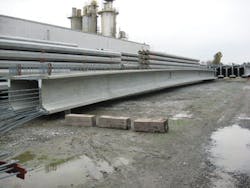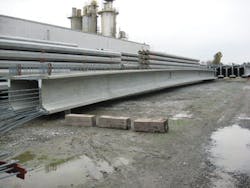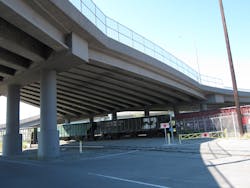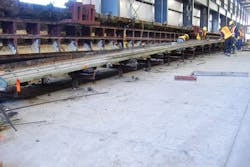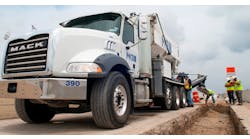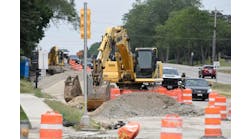By: Hong Guan, Ph.D., S.E., Mark Johnson, P.E., and Yuling Teo, P.E.
The East Marginal Way Grade Separation (EMWGS) project is located at the intersection of two major traffic corridors in an industrial district just south of Seattle.
In the north-south direction is the Washington S.R. 99 corridor linking downtown Seattle to the industrial areas in the south. In the east-west direction, the South Spokane Street Viaduct and the West Seattle Bridge connect the Port of Seattle and the West Seattle neighborhood to I-5 and I-90 in the east. This area also is crisscrossed by freight railroad mainlines and spurs, serving Port of Seattle terminals and the surrounding industrial area. In addition to being a designated Washington State Freight Economic Corridor, it also is the most significant route of choice for the West Seattle neighborhood residents biking into Seattle.
Prior to the project, the at-grade crossing—where East Marginal Way crosses the Union Pacific Railroad (UPRR) and the Burlington Northern Santa Fe (BNSF) tracks—was shared by freight trains, trucks and general traffic as well as bicyclists and pedestrians. On average, the corridor would see 3,000 trucks daily and 34,000 bike trips monthly. It was a traffic choke point, with average daily blockage time at more than two hours, impacting air quality and access for local businesses. Improving traffic flow and safety was critically needed.
The purpose of the project was to improve freight mobility, safety and circulations for all transportation modes, including bikes and pedestrians. The project was to grade-separate the north-south traffic on East Marginal Way from the UPRR and BNSF railroad tracks, which run in the east-west direction. It was anticipated that 400 to 600 vehicles per hour would cross the new structure. The projected benefits included reduced accident rates and less pollution due to minimal truck idling. Also, the local economy would receive a boost as a result of less congestion and delay.
A one-piece, precast, pretensioned girder ready to go.
Vertically challenged
The project site is geometrically constrained on all sides due to existing adjacent bridge structures (S.R. 99 and Spokane Street Viaduct), existing street grids, major utilities (both underground and overhead), railroad tracks and local business parcels. The challenge of fitting an elevated grade-separation structure within this confined footprint called for a solution that was unique in many ways. The superstructure of the four-span overpass forms a Y-shape, with two end-spans extending to the east and west, north of the railroad tracks, and another end-span leading southeast of the railroad tracks. All three end-spans merge at a trapezoidal-shaped center span over the railroad tracks.
In addition to curving and flaring in the horizontal plane, the structure also has significant vertical curvature. The length of the approach was limited by available space and distance to adjacent structures. At the time of design, the owner of the structure, the Seattle Department of Transportation (SDOT), required a concrete overpass with a vertical profile grade of no greater than 7% to avoid triggering the need for deicing. Deicing was undesirable because of the associated long-term operational and maintenance costs. The limits on the vertical profile grade and the need to provide necessary vertical clearance over the railroad tracks and roadway meant that a conventional straight precast concrete girder solution would not be possible. As a result, the bridge was initially designed and sent out to bid as a post-tensioned hybrid cast-in-place/precast concrete structure. The design and geometry were complex, requiring extensive falsework in close proximity with active railroad tracks, resulting in higher estimated construction costs and a longer schedule.
Breaking out the one-piece
The elevated structure was contracted as a conventional design-bid-build project. Shortly after winning the project, the contractor offered a Cost Reduction Incentive Proposal (CRIP) to the owner. In the CRIP, the contractor proposed to replace the original post-tensioned hybrid concrete superstructure with the Washington State Department of Transportation (WSDOT) standard precast, pretensioned concrete wide-flange I-girders. WSDOT standard wide-flange I-girders (or “WF girders” as they are known in Washington) are the most prevalent and economical concrete girder sections in Washington, with a historical unit cost that is 20-30% lower than comparable bridge types, such as post-tensioned cast-in-place concrete or steel. This relative economy is due to the girders’ inherent material cost advantage, and the fact that they require less specialized equipment for erection and construction. This has allowed more contractors to be familiar with their construction, which encourages competitive bidding.
Using one-piece, precast, pretensioned girders also would help to accelerate the bridge construction by reducing the need for falsework near railroad tracks, eliminating one of the biggest schedule constraints and mitigating impacts to railroad operations. A precast I-girder superstructure turned out to be about one-third lighter than the original post-tensioned design, allowing for smaller substructure and foundations, further reducing the cost.
However, the proposed revised design also introduced unique technical challenges. Not only did each precast girder have a different length and design to accommodate the unusual deck geometry, but the girders for the center span would need to be designed with built-in vertical profile to provide necessary vertical clearance over railroad tracks.
The precast I-girder superstructure was one-third lighter than a post-tensioned alternative and afforded the necessary clearance allowance for the underlying railroad throughway.
A rare occurrence
“Pre-camber” of precast pretensioned concrete girders refers to a “built-in” vertical profile to the girder that is either additive or subtractive to the natural camber that occurs during the girder pretensioning and curing process. Unlike steel or cast-in-place concrete bridge construction, where cambering of the girder is a routine practice, cambering of precast pretensioned concrete girders is relatively rare. Only recently was the concept applied to pretensioned I-girders to increase the upward curvature of the girder. The increased curvature serves two purposes: It provides additional vertical clearance under the bridge, and secondly, it helps to minimize the concrete deck build-up on top of the precast girders required to match the roadway vertical profile.
Pre-camber is achieved by building in the required curvature (usually a parabolic shape) in the bottom form of the I-girder on the casting bed. The straight strands near the bottom of the girder are held close to the curved bottom profile by strand deflectors placed at regular intervals. The harped strands, if present, are usually chorded between the girder ends and the harp points, and follow the curved bottom profile between harp points. The rest of the casting procedure is similar to conventional straight precast concrete girders.
The maximum pre-camber built into the girders for the EMWGS project was 131⁄8 in. At the time of construction, it was one of the largest pre-camber for wide-flange I-girders fabricated in Washington State.
Consider the variability
The variability inherent in predicting camber has long been a recognized issue for precast concrete girders. In most cases, the camber value of critical importance is the girder camber at the time of deck casting. This value affects the buildup on top of the girder to achieve the desired roadway profile, and in some cases, the vertical clearance under the bridge. There are many factors affecting the camber of prestressed girders, such as the modulus of elasticity in concrete, the storage time between girder casting and deck casting, and the distance between bunking points and girder ends when girders are stored in the yard. These factors are either difficult to predict accurately (in the case of modulus of elasticity) or are usually beyond the control of the designer (as in the cases of storage time and bunking points). Some research has suggested the variability of camber prediction at the time of deck casting can be in the range of ±50%. If the actual camber is larger than predicted, the top of the girder may encroach into the deck and interfere with the deck reinforcement. On the other hand, if the actual camber is less than predicted, the vertical clearance underneath the bridge may be affected.
The actual measured camber for this project turned out to be significantly less than predicted. The measured girder camber at the time of deck casting was consistently lower than predicted values, sometimes by as much as 50%. The reduced camber decreased the vertical clearances underneath the bridge. Fortunately, the reduction was not significant enough to cause encroachment of railroad clearance envelopes. The reduced camber also meant that the girder haunch/buildup was thicker than expected, resulting in an increased weight of the deck buildup that had to be considered in the design. Additionally, some of the shear stirrups in the girder were not long enough to hook around the deck longitudinal reinforcement. To provide enough horizontal shear capacity, additional U-shaped stirrups were added in the buildup. In light of these experiences, it would be advisable to include the consideration for camber variability in the design. This can be achieved by providing details that can accommodate ±50% camber variability. For example, girder shear stirrups that are longer than the nominally required length can be provided. These stirrups can be field-bent around deck reinforcing steel. Alternatively, additional U-shaped stirrups can be provided in the case of deficient camber.
Crews working on the curved girder bottom form.
Reserved for three
The innovative use of pre-cambered, pretensioned concrete girders allowed a precast structure to be built in a highly constrained urban site with a challenging geometric footprint. While taking advantage of the speed and economy of pretensioned girder construction, pre-cambering afforded ways for precast girders to be used in situations formerly reserved for cast-in-place concrete or steel girders, further expanding the versatility of precast concrete girders.
About The Author: Guan and Johnson are engineers with CH2M Hill. Teo is with the Seattle Department of Transportation.
